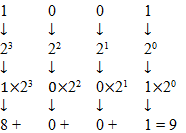
Concept explainers
To express:
A binary number into a hexadecimal number.
Answer to Problem 16A
Hexadecimal number is 10AB.92616.
Explanation of Solution
Given information:
A binary number 1000010101011.100100100112.
Calculation:
Binary number system uses the number 2 as its base. Therefore, it has 2 symbols: The numbers are 0 and 1.
And a hexadecimal number system uses the number 16 as its base i.e. it has 16 symbols. The hexadecimal digits are 0, 1, 2, 3, 4, 5, 6, 7, 8, 9, A, B, C, D, E and F.
Binary numbers are represented as from hexadecimal number
| Binary | 0000 | 0001 | 0010 | 0011 | 0100 | 0101 | 0110 | 0111 |
| Decimal | 0 | 1 | 2 | 3 | 4 | 5 | 6 | 7 |
| Hexadecimal | 0 | 1 | 2 | 3 | 4 | 5 | 6 | 7 |
| Binary | 1000 | 1001 | 1010 | 1011 | 1100 | 1101 | 1110 | 1111 |
| Decimal | 8 | 9 | 10 | 11 | 12 | 13 | 14 | 15 |
| Hexadecimal | 8 | 9 | A | B | C | D | E | F |
Each hexadecimal digit consists of 4 binary digits.
For example, hexadecimal number 9 is equal to binary number 1001.
For converting integer part of binary number into hexadecimal number, write down the binary number and represent four binary digits from right by its hexadecimal digit from the table.
Then combine all the digits together.
For converting fractional part of binary number into hexadecimal number, write down the binary number and represent four binary digits from left by its hexadecimal digit from the table.
Then combine all the digits together.
Finally, hexadecimal number is combination of both integer and fractional part.
Hexadecimal digits are equal to the summation of 2n where n = 0, 1, 2 and 3 (position from right).
For example, 9 = 23+20. In this example, 21 and 22are not there. So, at position 1 and 2, binary digit is zero, and at position 0 and 3, binary digit is one. Therefore, hexadecimal of binary 1001 is

The hexadecimal number is equal to the summation of binary digits dn × 2n
Divide the binary number into block of four digits. If four digits are not there, then add additional zero in binary number. For example, 11 is written as 0011 and .11 is written as .1100.
Hexadecimal of binary number 1100100101001011.10010010012 is (Starting from right for integer part and starting from left for fractional part)
Want to see more full solutions like this?
Chapter 83 Solutions
Mathematics for Machine Technology
- One-Sample Z Test Test of М = 45 vs not === 45 The assumed standard deviation = 2.8 VARIABLE N MEAN STDEV SE MEAN X Instructions: 46.377 2.500 0.626 95% CI (,) Fill in the missing values. N: Round the answer to the nearest whole number. Cl: Round to three decimal places. Z: Round to two decimal places. P: Round to three decimal places.arrow_forwardNeed detailed report solution without AI and Chatgpt,arrow_forwardBased on the software output, write the fitted simple linear regression equation. Coefficients Term Coef SE Coef T-Value P-Value Constant 3.20 1.92 1.67 0.237 [Select] y= 0.600 0.566 1.06 0.400 +[Select] x Does a simple linear regression model seem reasonable in this situation? [Select]arrow_forward
- 30.4. Suppose that f(2) has a pole of order m at zo. Show that f'(z) has a pole of order m + 1 at zo-arrow_forwardA drink filling machine, when in perfect adjustment, fills the bottles with 8 ounces of drink on an average. Any overfilling or underfilling results in the shutdown and readjustment of the machine. A sample of 20 bottles is selected, and the sample shows an average filling volume of 7.5 ounces. To determine whether the machine is properly adjusted, the correct set of hypotheses Ho: [Select] [Select] H₁: [Select] [Select] > [Select] [Select]arrow_forwardInformation on a packet of seeds claims that 93% of them will germinate. Of the 200 seeds that were planted, only 180 germinated. 95% confidence interval for the true proportion of seeds that germinate based on this sample is (85.8%, 94.2%). Do the data provide evidence against the claim? [Select] The margin of error in the estimate is: [Select] > To keep the margin of error within 3.5% with at least 95% confidence level, the required sample size is: [Select]arrow_forward
- This has to be done advanced mathematics report , also give the code for this. And do not give chatgptarrow_forwardConsider a set of data ...arrow_forwardDesign a Turing Machine recognizing each of the following languages and draw its state diagram. Note that the transition functions of the Turing Machine must be in the format of “a → b,L/R", namely the machine reads single symbol a from the tape, writes single symbol b to the cell to replace a, and then goes to either left L or right R. You will receive 0 point if you do not follow this instruction. (1) {w|w=a²b³, n ≥ 0} (2) {w|w=a'b³,i0} (3) {w|w a'bick,iarrow_forwardDesign a PDA recognizing each of the following languages and draw its state diagram. Note that the transition function must be in the format of “a, b →c", namely we can only push/pop one symbol into/from the stack one time upon one input symbol. You will receive 0 point if you push/pop multiple symbols into/from the stack one time upon one input symbol. (1) {w|wa"b", n is odd} = (2) {w|w=w², length of w is odd and Σ = {a,b} } (3) {w|w= = a²b²n, n ≥1 } (4) {w|w= =a^bn+mcm, n≥0, m ≥ 1 } (5) {w|w=a²b³n, n≥0} (6) {w|w= = a¹³, n ≥ 1, m≥ 1 and n‡m } Hint: two cases: n > m and narrow_forward[) Hwk 29 ✗ WHwk 30 (MA 244-03) (SP X - Logout Cengage Learning X MA244-03 Syllabus_Sprin X b Answered: [) Hwk 29 Hwk X https://www.webassign.net/web/Student/Assignment-Responses/last?dep=36606609 4. [-/3 Points] DETAILS MY NOTES LARLINALG8 7.4.013. Solve the system of first-order linear differential equations. (Use C1 and C2 as constants.) Y1' = -4Y1 Y2' = -12 (y1(t), Y2(t)) = ( 3 Need Help? Read It SUBMIT ANSWER 5. [-/3 Points] DETAILS MY NOTES LARLINALG8 7.4.019. Solve the system of first-order linear differential equations. (Use C1, C2, C3, and C4 as constants.) Y1' = 6y1 Y2' = 2y2 Y3' = -643 Y4' = -2y4 = (y1(t), y2(t), y3(t), Y4(t)) = Need Help? Read It SUBMIT ANSWER G Use the Principal Axes The X G cot(0) - Google Search ☑ B 90% + ASK YOUR TEACHER PRACTICE ANOTHER ill ASK YOUR TEACHER PRACTICE ANOTHER 6. [-/4 Points] DETAILS MY NOTES LARLINALG8 7.4.023. Solve the system of first-order linear differential equations. (Use C1 and C2 as constants.) ASK YOUR TEACHER Y1' = Y1 + 5y2 Y2'…arrow_forward[) Hwk 29 SUBMIT ANSWEK Hwk 30 - (MA 244-03) (SP25) || X - Mind Tap Cengage Learning ☑ MA244-03_Syllabus_Spring, 20 × b Answered: [) 90% Hwk 29 Hwk X Rotation of Axes Example - Elimi X + https://www.webassign.net/web/Student/Assignment-Responses/last?dep=36606609 B שי 90% 2. [-/3 Points] DETAILS MY NOTES LARLINALG8 7.4.003. Use the age transition matrix L and age distribution vector X1 to find the age distribution vectors X2 and x3. 0 34 x2 = X3 = L = ↓ ↑ 1 0 0 x1 = 1 0 0 2 20 20 20 Then find a stable age distribution vector. x = t ↓ 1 Need Help? Read It SUBMIT ANSWER 3. [-/3 Points] DETAILS MY NOTES LARLINALG8 7.4.004. Use the age transition matrix L and age distribution vector X1 to find the age distribution vectors x2 and ×3. ill { ASK YOUR TEACHER PRACTICE ANOTHER ASK YOUR TEACHER PRACTICE ANOTHERarrow_forwardarrow_back_iosSEE MORE QUESTIONSarrow_forward_iosRecommended textbooks for you
 Mathematics For Machine TechnologyAdvanced MathISBN:9781337798310Author:Peterson, John.Publisher:Cengage Learning,
Mathematics For Machine TechnologyAdvanced MathISBN:9781337798310Author:Peterson, John.Publisher:Cengage Learning,
 Mathematics For Machine TechnologyAdvanced MathISBN:9781337798310Author:Peterson, John.Publisher:Cengage Learning,
Mathematics For Machine TechnologyAdvanced MathISBN:9781337798310Author:Peterson, John.Publisher:Cengage Learning,